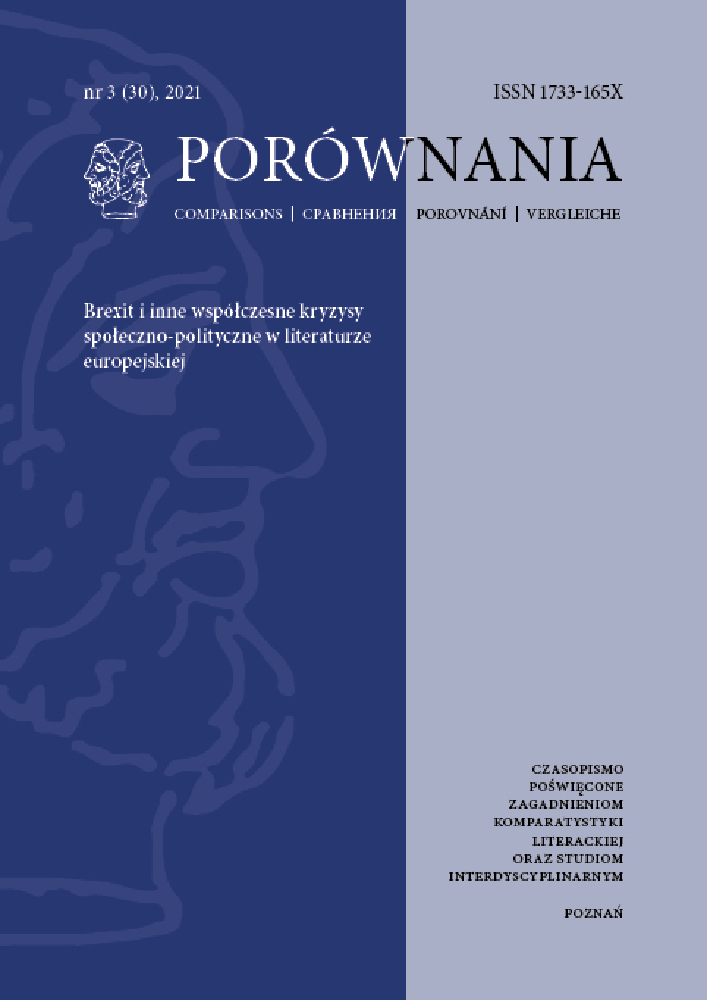Abstract
Cold Eye of Heaven (2011) shows pre-Brexit Dublin steeped in the post-Celtic Tiger anxieties. The novel narrates the life of a contemporary Everyman, Charley Grainger, known as Farley, from his final moments back to his childhood. Thus, Farley’s journey envisages both a Joycean interior monologue depicting his old-age bafflement in the meanders of memory and a realistic description of the character’s bewilderment at the changes in the cityscapes of the Dublin of 2010. The present paper is a comparative study of the first two chapters of the novel in reference to the history of the city present in the entire text, through the use of the tropes of the mental and urbane labyrinths. Imbued with the allusions to current reality, i.e., the presence of immigrants, Hickey’s observations are in line with Joycean anti-nationalism, as the story offers a nostalgia-stricken picture of the inevitable economic transformation of the metropolis.
References
Alter, Robert. Imagined Cities: Urban Experience and the Language of the Novel. New Haven and London: Yale University Press, 2005.
Anderson, Benedict. Imagined Communities. London: Verso, 2006 [1983].
Attridge, Derek, ed. The Cambridge Companion to James Joyce. Cambridge: Cambridge University Press, 1999 [1990].
Beckett, Samuel. Three Novels. Molloy, Malone Dies, The Unnamable. New York: Grove Press, 1958 [1955].
Corcoran, Neil. After Yeats and Joyce: Reading Modern Irish Literature. Oxford: Oxford University Press, 2003.
Cronin, Anthony. Samuel Beckett. The Last Modernist. London: Flamingo.
Deane, Seamus. “Joyce the Irishman.” The Cambridge Companion to James Joyce. Ed. Derek Attridge. Cambridge: Cambridge University Press, 1999 [1990]. 31–53.
Doob, Penelope Reed. The Idea of the Labyrinth: From Classical Antiquity through the Middle Ages. Ithaca and London: Cornell University Press, 1992 [1990].
Fanning, Bryan. New Guests of the Irish Nation. Dublin: Irish Academic Press, 2009.
Fanning, Bryan. Immigration and Social Cohesion in the Republic of Ireland. Manchester: Manchester University Press, 2011.
Foster, R.F. Modern Ireland. 1600–1972. London: Penguin, 1989 [1988].
Hickey, Christine Dwyer. The Dancer. Dublin: New Island, 2005 [1995].
Hickey, Christine Dwyer. The Gambler. Dublin: New Island, 1996.
Hickey, Christine Dwyer. The Gatemaker. Dublin: New Island, 2000.
Hickey, Christine Dwyer. Last Train from Liguria. London: Atlantic Books, 2009.
Hickey, Christine Dwyer. Cold Eye of Heaven. London: Atlantic Books, 2012 [2011].
Hickey, Christine Dwyer. The House on Parkgate Street and Other Dublin Stories. Dublin: New Island, 2013.
Hickey, Christine Dwyer. The Narrow Land. London: Atlantic Books, 2019.
Howes, Marjorie and John Kelly, eds. The Cambridge Companion to W. B. Yeats. Cambridge: Cambridge University Press, 2006.
Jaskolski, Helmut. The Labyrinth: Symbol of Fear, Rebirth, and Liberation. Boston and New York: Shambhala; Prospect Hills, Illinois: Waveland Press, Inc., 1997.
Joyce, James. Ulysses: The Complete and Unabridged Text. New York: Vintage International, 1990 [1934].
Joyce, James. Occasional, Critical, and Political Writing. Ed. Kevin Barry. Trans. Conor Deane. Oxford: Oxford University Press, 2000a [1993].
Joyce, James. A Portrait of the Artist as a Young Man. [Edited by Jeri Johnson]. Oxford: Oxford University Press, 2000b [1964].
Joyce, James Dubliners. [Edited by Jeri Johnson]. Oxford: Oxford University Press, 2000c [1967].
Kearney, Richard. Postnationalist Ireland: Politics, Culture, Philosophy. London: Routledge, 1997.
Kearney, Richard. On Stories. London and New York: Routledge, 2002.
Kiberd, Declan. Inventing Ireland: The Literature of the Modern Nation. London: Vintage, 1996 [1995].
Lefebvre, Henri. The Production of Space. Trans. Donald Nicholson-Smith. Oxford: Blackwell Publishing, 2005 [1991].
Lehan, Richard. The City in Literature: An Intellectual and Cultural History. Berkeley: University of California Press, 1998.
Lloyd, David. Anomalous States: Irish Writing and the Post-Colonial Moment. Durham: Duke University Press, 1993.
Lofland, Lyn H. A World of Strangers. Order and Action in Urban Public Space. Prospect Heights, Illinois: Waveland Press, Inc., 1973.
Longley, Edna, and Declan Kiberd. Multi-Culturalism: The View from the Two Irelands. Cork: Cork University Press, 2001.
McCullough, David Wills. The Unending Mystery: A Journey Through Labyrinths and Mazes. New York: Anchor Books, 2004.
Pakenham, Thomas. The Year of Liberty. The Great Irish Rebellion of 1798. London: Abacus, 2004 [1969].
Paziński, Piotr. Dublin z Ulissesem. [Dublin with Ulisses]. Warszawa: Czuły Barbarzyńca Press, 2008.
Ryan, Donal. All we Shall Know. London: Black Swan, 2017 [2016].
Ryder, Chris. Inside the Maze. The Untold Story of the Northern Ireland Prison Service. London: Methuen, 2001 [2000].
Seidel, Michael. Epic Geography: James Joyce’s Ulysses. [Maps drawn by Thomas Crawford]. Princeton: Princeton University Press, 1976.
Tindall, W. Y. James Joyce: His Way of Interpreting the Modern World. New York: Charles Scribner and Sons, 1950.
Vendler, Helen. “The Later Poetry.” The Cambridge Companion to W. B. Yeats. Eds. Marjorie Howes and John Kelly, 2006. 77–100.
Welch, Robert. Changing States: Transformations in Modern Irish Writing. London: Routledge, 2004 [1993].
License
Utwory opublikowane w czasopiśmie „Porównania”, na platformie Pressto należącej do Uniwersytetu im. Adama Mickiewicza w Poznaniu są udostępniane na licencji Creative Commons Uznanie autorstwa - Bez utworów zależnych 4.0 Międzynarodowe (CC BY-ND 4.0)
Tym samym wszyscy zainteresowani są uprawnieni do korzystania z utworów opublikowanych pod następującymi warunkami:
-
uznania autorstwa — czyli obowiązek podania wraz z rozpowszechnianym utworem informacji o autorstwie, tytule, źródle (odnośniki do oryginalnego utworu, doi) oraz samej licencji
-
bez utworów zależnych — remiksując, przetwarzając lub tworząc na podstawie utworu, nie wolno rozpowszechniać zmodyfikowanych treści.
-
brak dodatkowych ograniczeń — nie można korzystać ze środków prawnych lub technologicznych, które ograniczają innych w korzystaniu z utworu na warunkach określonych w licencji.
Uniwersytet im. Adama Mickiewicza w Poznaniu zachowuje prawo do czasopisma jako całości (układ, forma graficzna, tytuł, projekt okładki, logo itp.).
Autor zachowuje prawa majątkowe, ale udziela zgody Uniwersytetowi im. Adama Mickiewicza w Poznaniu na wykorzystanie dzieła. Autorzy tekstów zakwalifikowanych do publikacji proszeni są o wypełnienie podpisanie i przesłanie umowa (PL) agreement (EN)
Agreement for granting a royalty-free license to works with a commitment to grant a CC sub-license





